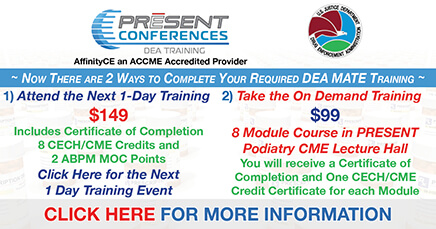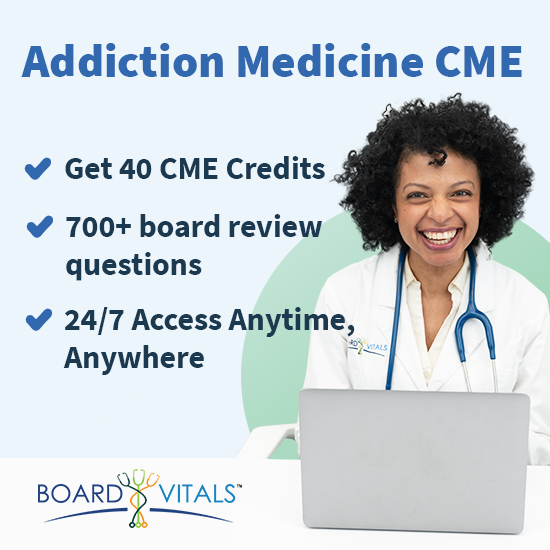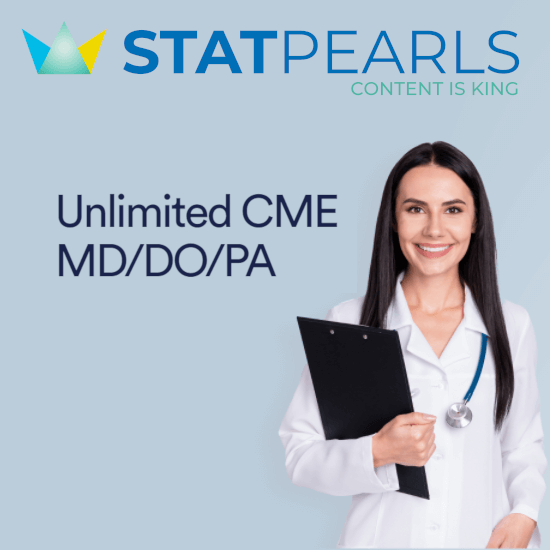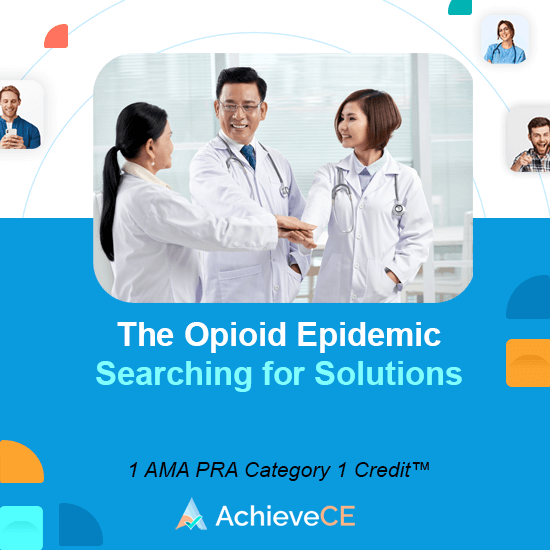Addiction Medicine CME
1 - 7 of 7 results
-
PRESENT DEA Mate Training – Complete Your Required Training
All DEA-registered practitioners have training requirements due at DEA registration renewal. With the enactment of the Consolidated Appropriations Act of 2023, the DEA now requires you to complete a one-time, eight-hour training requirement on the treatment and management of patients with opioid substance use disorders. PRESENT offers On-Demand Lectures Modules to complete your DEA CME requirements. Required for all renewals and new DEA registrations, this program was developed and accredited by AffinityCE, an ACCME Accredited and DEA-Qualified Provider.
See full details chevron_right- Cost: $199
- Credit hours: 8
-
30% OFF W/ CODE: CME30
Oakstone CME Addiction Medicine for Non-Specialists
This activity meets the Drug Enforcement Administration (DEA) and Substance Abuse and Mental Health Services Administration (SAMHSA) requirement that as of June 27, 2023, new or renewing DEA registrants must complete a minimum of 8 hours of accredited continuing education (CE) on the treatment and management of patients with opioid or other substance use disorders before renewing their license.
See full details chevron_right- Cost: $595
- Credit hours: 24.75
- CME credits awarded by: Oakstone Publishing, LLC.
- Format: On-Demand Online
- Material last updated: April 30, 2025
- Expiration of CME credit: April 29, 2028
-
BoardVitals Addiction Medicine CME Board Review
The BoardVitals Addiction Medicine CME Review offers clinicians 40 AMA PRA Category 1 CreditsTM and over 700 Addiction Medicine board review questions. The questions cover key topics including recognition, intervention, and treatment of addiction. This question bank will assist clinicians with Addiction Medicine certification and recertification.
The BoardVitals Addiction Medicine CME Review also features:
- Quick and Convenient CME
- Computer, phone, and tablet access
- Constantly updated up-to-date questions
- Questions that are targeted specifically to the exam
- Online CME tracker
- 100% Pass Guarantee
- Statistical comparison to other Addiction Medicine test-takers (Nationally)
After completing this activity, you should be able to:
- Identify the most commonly abused substances
- Recognize the most common indicators and symptoms of substance abuse and pain medicine dependency
- Describe the underlying pathophysiology of disease and basic science knowledge
- Formulate treatment for chronic pain management and substance abuse
Target Audience: Care providers concerned about issues of chronic pain and substance abuse.
See full details chevron_right- Cost: $599
- Credit hours: 40
- CME credits awarded by: BoardVitals
- Format: On-Demand Online
- Material last updated: Continuously Updated
-
FEATUREDRECOMMENDED
MDCalc CME Bundle w/ $3,500 Amazon or Visa Gift Card
Maximize your CME allowance with MDCalc and get up to a $3,500 bonus gift card of your choice. Earn AMA PRA Category 1 CreditsTM for clinical content on 150+ calculators across multiple medical specialties. Easily earn and redeem CME at the point-of-care, online on our website or mobile app. Over 1 million medical professionals use MDCalc’s 550+ tools daily to support clinical decision making at the bedside.
See full details chevron_right- Cost: Varies
- Credit hours: Unlimited
- CME credits awarded by: EBMedicine
- Format: On-Demand Online
- Material last updated: Continuously Updated
-
StatPearls Unlimited Physician MD/DO/PA CME
Stay on top of your game with the StatPearls Physician Unlimited CME programs. With 6,046 activities, StatPearls is the largest CME provider in the world. These Pub-Med Indexed articles are categorized into 162 specialty areas which lets you better access activities that will make the biggest impact on your practice. One subscription allows access to all the activities, including all state-requirements.
Pricing Options
- 6 Month subscription: All 6,339 CME Activities – $249 per 6 months
- Annual subscription: All 6,339 CME Activities – $349 per 1 year
- Lifetime: All 6,339 CME Activities + Access to Board Reviews Forever – $1999
- Cost: Varies
- CME credits awarded by: ETSU
- Format: On Demand Online & Board Reviews
-
BoardVitals Addiction Medicine Board Review Question Bank
The BoardVitals Addiction Medicine Board Review Question Bank offers over 800 Addiction Medicine Certification Review / Addiction Board Review questions. The exams cover recognition, intervention, and treatment of addiction. This question bank specifically covers the topics published by the ABAM and ABPN for Addiction Medicine Certification.
The BoardVitals Addiction Medicine Board Review Question Bank features:
• Timed Mode
• Statistical Comparison to Other Addiction Medicine Test Takers (Nationally)
• Questions That are Targeted Specifically to the Exam
• 100% Pass GuaranteeTarget Audience: Physicians focusing on Addiction Medicine
See full details chevron_right- Cost: $149
- Credit hours: 40
- CME credits awarded by: University of Nebraska Medical Center
- Format: On-Demand Online
- Material last updated: Continuously Updated
-
AchieveCE The Opioid Epidemic: Searching for Solutions Webcast
According to the 2015 National Survey on Drug Use and Health, approximately 3.8 million people (1.4% of those ages 12 or older) reported misusing prescription pain relievers, while another 329,000 people reported using heroin. Within the same year, 52,404 lethal overdoses took place, making drug overdose the leading cause of accidental death within the United States. Stancliff et al estimated that as of 2012, approximately 80% of people dependent on heroin or prescription opioids were not engaged in any treatment and many in treatment do not use the most effective medication-assisted treatments available to them.
Despite recent increased awareness of opioid use disorder (OUD) and efforts to improve access to care, several barriers to treatment still exist, including financial, geographic, regulatory, and social. In 2012, only 2.2% of physicians in the United States obtained waivers to prescribe buprenorphine for the treatment of OUD. Of those who received waivers, 41.6% were psychiatrists. This may be perceived as a potential barrier to OUD treatment as patients are often resistant to referrals to psychiatric and/or addiction clinics given the stigmas commonly surrounding addiction and mental health. Furthermore, physicians with waivers were found to practice primarily in urban settings, leaving a large portion of the rural population without access to buprenorphine treatment.
With all this in mind, education is needed in regards to current and emerging treatment options for OUD available to multiple patient populations. Also, with the deaths due to drug overdoses still elevated, education on how to recognize and reverse an opioid overdose is needed.
This presentation will address the above needs by discussing the science behind opioid use disorder as well as reflect upon current statistics associated with its impact on the United States. During the discussion, opioid overdose risks will be discussed and participants will be able to practice recognizing key symptoms of an overdose situation. Steps of using naloxone will be discussed and connected to how to appropriately seek out treatment for maintenance of opioid use disorder. Finally, new buprenorphine products and the potential role of naltrexone will be applied to this stigmatized population.
See full details chevron_right- Cost: $15
- Credit hours: 1
- CME credits awarded by: Continuing Education Company, Inc. and AchieveCE, ACPE, AGD PACE, and ANCC
- Format: Online Video
- Material last updated: 07/31/2024
- Expiration of CME credit: 07/31/2027







